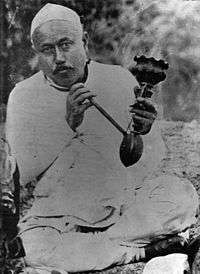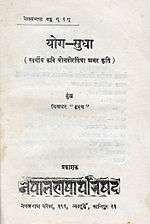Yogbir Singh Kansakar
Yogbir Singh Kansakar (Devanagari: योगवीरसिं कंसकार) (alternative name: Jogbir Singh Kansakar) (16 April 1885 - 29 March 1942) was a Nepalese poet, social reformer and one of the Four Pillars of Nepal Bhasa.[1] He worked to develop his mother tongue and promote Buddhism in the face of repression by the Rana rulers.[2][3][4]


Kansakar was the guru and inspiration of Chittadhar Hridaya, one of the greatest literary figures of 20th-century Nepal.[5]
Early life
Kansakar was born at Kel Tol, Kwachhen Nani, Kathmandu. His father was Chaityabir Singh and his mother was Laxmi Nani. The family owned a cloth shop. As a young man in 1905, Kansakar got involved in the social reformist activities of an organization known as Arya Samaj. He was fined and jailed by the Ranas for promoting an unorthodox religion.[6] Out of prison, a dejected Kansakar went to Kolkata, India where he was inspired by the activity in Bengali language publication and love of literature among Bengalis.[7][8]
Career
Returning to Kathmandu, Kansakar took to writing poetry, and his cloth shop was turned into a gathering place for poets.[9] Each week, they would bring a copybook filled with their compositions and discuss each other's works. When the Bada Guruju (chief royal priest) came to know about it, he had all the copybooks confiscated.
Inspired by Tulsi Meher's homespun movement, Kansakar campaigned to popularize homespun and encouraged people to install handlooms in their homes. In 1927, he established a company named Vastrakala Bhavan to produce textiles. Kansakar was an advocate of female education, and he sent his daughter Vidyabati Kansakar to India among the first batch of students to receive nurse training.[10]
Library incident
In 1929, Kansakar headed a committee which petitioned the prime minister to be allowed to open a library. Kansakar and the rest of the signers of the appeal were arrested and fined.[11][12] In 1934, all the Newar authors were summoned before the prime minister and warned to stop writing in Nepal Bhasa.[13]
Kansakar also worked to promote Theravada Buddhism which aroused the anger of the government. In 1931, he was fined and jailed with 11 other people including Buddhist teacher Dhammalok Mahasthavir, poet Chittadhar Hridaya and trader Dharma Man Tuladhar for trying to spread an "unorthodox religion".[14] He was also harassed and flogged for his activities.[15]
His wife Shobha Laxmi died in 1937, and he married Buddha Maya. In 1940, the government mounted a clampdown against political workers, writers and anybody it saw as a threat to the state. Kansakar was arrested and held for 85 days.[16]
An anthology of Kansakar's poems entitled Yog-Sudha was published by Nepal Bhasa Parisad in 1951.[17]
Legacy
A street in central Kathmandu was named Yogbir Singh Marg in his honor by Kathmandu Metropolitan City.[18]
References
- "Contributions to Nepalese Studies, Volume 22". Institute of Nepal and Asian Studies, Tribhuvan University. 1995. Missing or empty
|url=(help) Page 74. - Lienhard, Siegfried (1992). Songs of Nepal: An Anthology of Nevar Folksongs and Hymns. New Delhi: Motilal Banarsidas. ISBN 81-208-0963-7. Page 1.
- Tuladhar, Prem Shanti (2000). Nepal Bhasa Sahityaya Itihas: The History of Nepalbhasa Literature. Kathmandu: Nepal Bhasa Academy. ISBN 99933-56-00-X. Page 90.
- Sthavir, Dharmalok (1 December 1977). "A Journey to Great China". Regmi Research Series. Regmi Research. Retrieved 1 January 2012. Pages 35-36.
- Lewis, Todd T. and Tuladhar, Subarna Man (2009). Sugata Saurabha - An Epic Poem from Nepal on the Life of the Buddha by Chittadhar Hridaya. New York: Oxford University Press. ISBN 978-0-19-534182-9. Page 350.
- LeVine, Sarah and Gellner, David N. (2005) Rebuilding Buddhism: The Theravada Movement in Twentieth-Century Nepal. Harvard University Press. ISBN 978-0-674-01908-9. Page 41. Retrieved 6 January 2012.
- Hridaya, Chittadhar (1982, third ed). Jheegu Sahitya ("Our Literature"). Kathmandu: Nepal Bhasa Parisad. Page 93.
- Sudarshan, Bhikshu (1970). Lumanke Bahahpin ("Memorable Figures"). Kathmandu: Chwasa Pasa. Page 41.
- Shrestha, Bal Gopal (January 1999). "The Newars: The Indigenous Population of the Kathmandu Valley in the Modern State of Nepal)" (PDF). CNAS Journal. Retrieved 23 March 2012. Page 88.
- Tuladhar, Lochan Tara (August 2008). "Yogbir Singh Kasaa: A saga of selfless contributions". Matina. Pages 20-22.
- Dali, Indira (1991). "Libraries and information centres" (PDF). Libraries and information centres in Nepal: CEDA library and documentation branch. Singapore: Asian Mass Communication Research & Information Centre. Retrieved 6 March 2012. Page 17.
- Tumbahang, Govinda Bahadur (January 2010). "Marginalization of Indigenous Languages of Nepal". Contributions to Nepalese Studies. Retrieved 3 January 2012.
- Hridaya, Chittadhar (1982, third ed). Jheegu Sahitya ("Our Literature"). Kathmandu: Nepal Bhasa Parishad. Page 101.
- LeVine, Sarah and Gellner, David N. (2005). Rebuilding Buddhism: The Theravada Movement in Twentieth-Century Nepal. Harvard University Press. ISBN 0-674-01908-3, ISBN 978-0-674-01908-9. Page 41.
- Sthavir, Dharmalok (1 December 1977). "A Journey to Great China". Regmi Research Series. Regmi Research. Retrieved 11 October 2012. Pages 35-36.
- Sudarshan, Bhikshu (1970). Lumanke Bahahpin ("Memorable Figures"). Kathmandu: Chwasa Pasa. Page 56.
- Hridaya, Chittadhar (ed.) (1951) Yog-Sudha. Kathmandu: Nepal Bhasa Parisad. https://books.google.com.np/books/about/Yog_Sudha.html?id=i3DfcQAACAAJ&redir_esc=y
- "Addressed Road Network Map". Kathmandu Metropolitan City. Archived from the original on March 6, 2012. Retrieved 3 January 2012.